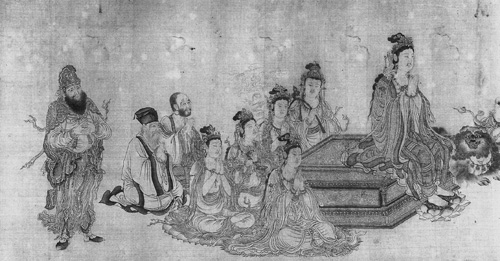Dogen Zenji once said: “As long as there is true bowing, the Buddha Way will not deteriorate.” In bowing, we totally pay respect to the all-pervading virtue of wisdom, which is the Buddha.
In making the bow, we should move neither hastily nor sluggishly but simply maintain a reverent mind and humble attitude. When we bow too fast, the bow is then too casual a thing; perhaps we are even hurrying to get it over and done with. This is frequently the result of a lack of reverence.
On the other hand, if our bow is too slow, then it becomes a rather pompous display; we may have gotten too attached to the feeling of bowing, or our own (real or imagined) gracefulness of movement. This is to have lost the humble attitude which a true bow requires.
When we bow, it is always accompanied by gassho [placing the hands together] although the gassho itself may not always be accompanied by bowing. As with the gassho, there are numerous varieties and styles of bowing, but here we will deal only with the two main kinds of bow which we use in our daily practice.
1. The Standing Bow. This bow is used upon entering the zendo, and in greeting one another and our teachers. The body is erect, with the weight distributed evenly and the feet parallel to each other. The appropriate gassho is made. As the bow is made, the body bends at the waist, so that the torso forms an angle with the legs of approximately 45 degrees. The hands (in gassho) do not move relative to the face, but remain in position and move only with the whole body.
2. The Deep Bow (Full Prostration). This bow is most often used at the beginning and end of services, and upon entering and leaving dokusan [interview with the teacher]. It is somewhat more formal than the standing bow, and requires a continuous concentration during its execution so that it is not sloppily done.
The bow itself begins in the same way as the standing bow, but once the body is bent slightly from the waist, the knees bend and one assumes a kneeling position. From the kneeling position, the movement of the torso continues, with the hands separating and moving, palms upward, into a position parallel with the forehead. As the bowing movement progresses, the backs of the hands come to rest just above the floor and the forehead is lowered until it rests upon the floor between the hands. At this point, the body is touching the floor at knees, elbows, hands, and forehead. The hands are then slowly raised, palms upward, to a point just above the ears. Then the hands slowly return to the floor. This action is a symbolic placing of the Buddha’s feet above one’s head as an act of reverence and humility. There should be no sharp, abrupt movements of the hands or arms, no bending of the wrists or curling of the fingers when executing this gesture. When the hands have been raised and lowered, the body then straightens as the person bowing gets to his feet once again and ends in gassho, just as he began. In kneeling, actually the knees do not touch the ground simultaneously, but in sequence; first the right and then the left knee touches the ground. The same is true for the right and left hands and right and left elbows, in that sequence. In practice, however, the interval between right and left sides touching the ground may be so minute as to be unnoticeable. In bowing, movement should not be jerky or disjointed, but should flow smoothly and continuously without either disruption or arrested motion.
Master Obaku, the teacher of Master Rinzai, was famous for his frequent admonition to his students, “Don’t expect anything from the Three Treasures.” Time after time he was heard to say this. One day, however, Master Obaku was observed in the act of bowing, and was challenged about his practice.
“You always tell your students not to expect anything from the Three Treasures,” said the questioner, “and yet you have been making deep bows.” In fact, he had been bowing so frequently and for so long that a large callous had formed on his forehead at the point where it touched the hard floor. When asked how he explained this, Master Obaku replied, “I don’t expect. I just bow.”
This is the state of being one with the Three Treasures. Let us just make gassho. Let us just bow.
♦
This excerpt from On Zen Practice II, edited by Taizan Maezumi Roshi and Bernard Tetsugen Glassman, is reprinted with the permission of the Los Angeles Zen Center.
Thank you for subscribing to Tricycle! As a nonprofit, we depend on readers like you to keep Buddhist teachings and practices widely available.
